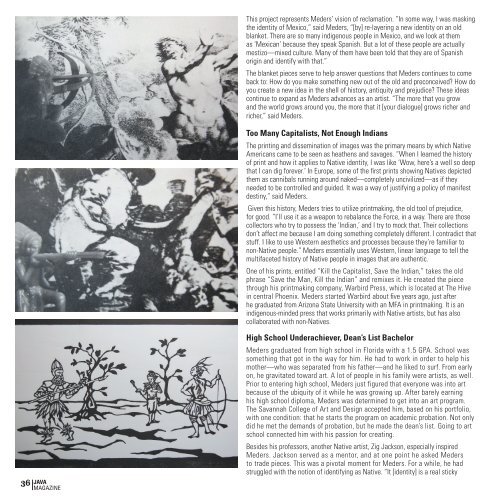Create successful ePaper yourself
Turn your PDF publications into a flip-book with our unique Google optimized e-Paper software.
This project represents Meders’ vision of reclamation. “In some way, I was masking<br />
the identity of Mexico,” said Meders, “[by] re-layering a new identity on an old<br />
blanket. There are so many indigenous people in Mexico, and we look at them<br />
as ‘Mexican’ because they speak Spanish. But a lot of these people are actually<br />
mestizo—mixed culture. Many of them have been told that they are of Spanish<br />
origin and identify with that.”<br />
The blanket pieces serve to help answer questions that Meders continues to come<br />
back to: How do you make something new out of the old and preconceived? How do<br />
you create a new idea in the shell of history, antiquity and prejudice? These ideas<br />
continue to expand as Meders advances as an artist. “The more that you grow<br />
and the world grows around you, the more that it [your dialogue] grows richer and<br />
richer,” said Meders.<br />
Too Many Capitalists, Not Enough Indians<br />
The printing and dissemination of images was the primary means by which Native<br />
Americans came to be seen as heathens and savages. “When I learned the history<br />
of print and how it applies to Native identity, I was like ‘Wow, here’s a well so deep<br />
that I can dig forever.’ In Europe, some of the first prints showing Natives depicted<br />
them as cannibals running around naked—completely uncivilized—as if they<br />
needed to be controlled and guided. It was a way of justifying a policy of manifest<br />
destiny,” said Meders.<br />
Given this history, Meders tries to utilize printmaking, the old tool of prejudice,<br />
for good. “I’ll use it as a weapon to rebalance the Force, in a way. There are those<br />
collectors who try to possess the ‘Indian,’ and I try to mock that. Their collections<br />
don’t affect me because I am doing something completely different. I contradict that<br />
stuff. I like to use Western aesthetics and processes because they’re familiar to<br />
non-Native people.” Meders essentially uses Western, linear language to tell the<br />
multifaceted history of Native people in images that are authentic.<br />
One of his prints, entitled “Kill the Capitalist, Save the Indian,” takes the old<br />
phrase “Save the Man, Kill the Indian” and remixes it. He created the piece<br />
through his printmaking company, Warbird Press, which is located at The Hive<br />
in central Phoenix. Meders started Warbird about five years ago, just after<br />
he graduated from Arizona State University with an MFA in printmaking. It is an<br />
indigenous-minded press that works primarily with Native artists, but has also<br />
collaborated with non-Natives.<br />
36 JAVA<br />
MAGAZINE<br />
High School Underachiever, Dean’s List Bachelor<br />
Meders graduated from high school in Florida with a 1.5 GPA. School was<br />
something that got in the way for him. He had to work in order to help his<br />
mother—who was separated from his father—and he liked to surf. From early<br />
on, he gravitated toward art. A lot of people in his family were artists, as well.<br />
Prior to entering high school, Meders just figured that everyone was into art<br />
because of the ubiquity of it while he was growing up. After barely earning<br />
his high school diploma, Meders was determined to get into an art program.<br />
The Savannah College of Art and Design accepted him, based on his portfolio,<br />
with one condition: that he starts the program on academic probation. Not only<br />
did he met the demands of probation, but he made the dean’s list. Going to art<br />
school connected him with his passion for creating.<br />
Besides his professors, another Native artist, Zig Jackson, especially inspired<br />
Meders. Jackson served as a mentor, and at one point he asked Meders<br />
to trade pieces. This was a pivotal moment for Meders. For a while, he had<br />
struggled with the notion of identifying as Native. “It [identity] is a real sticky


















